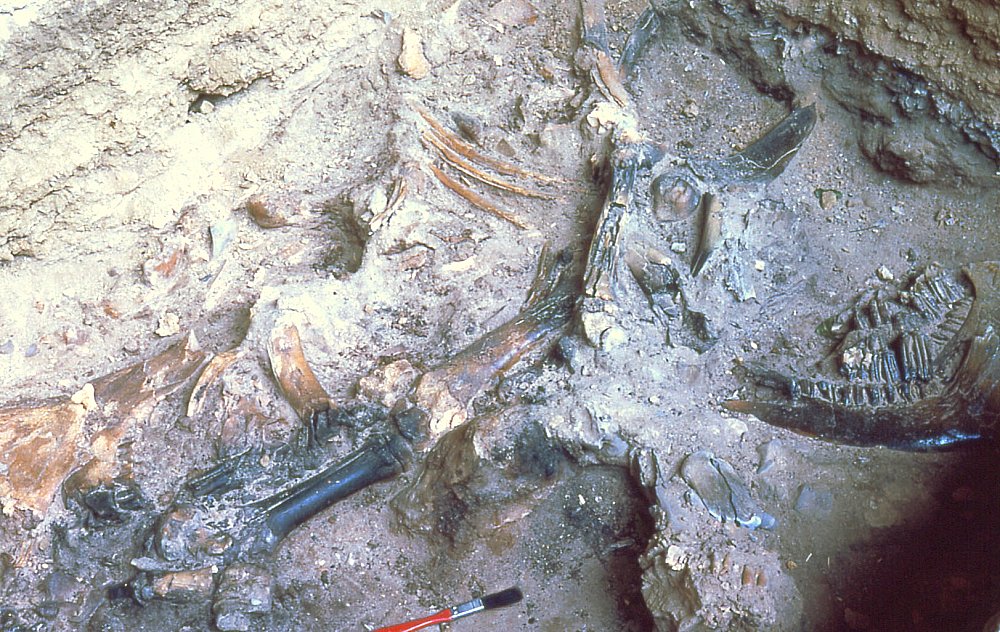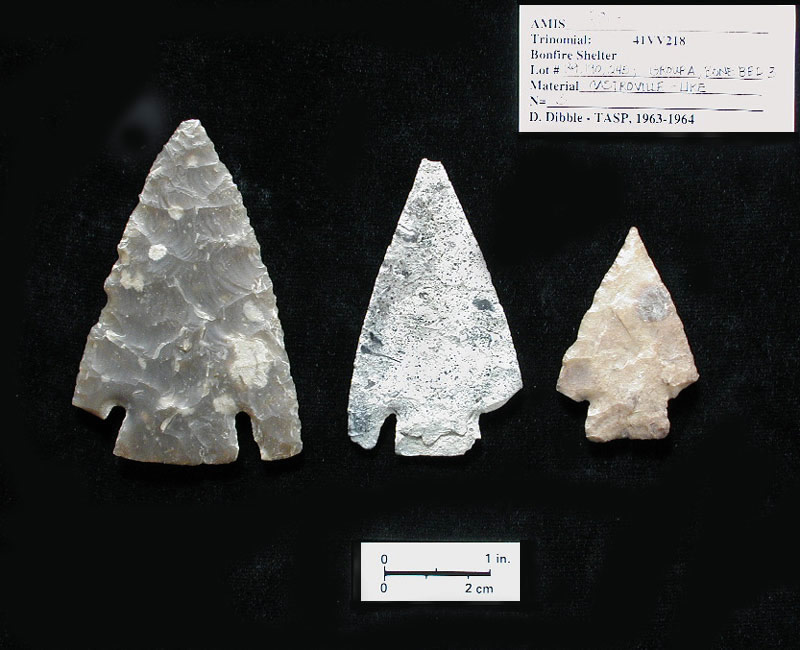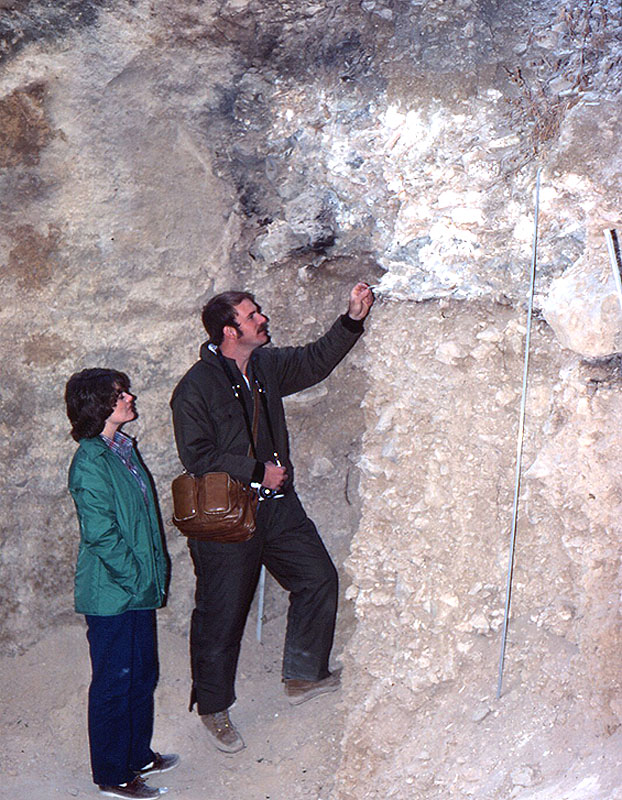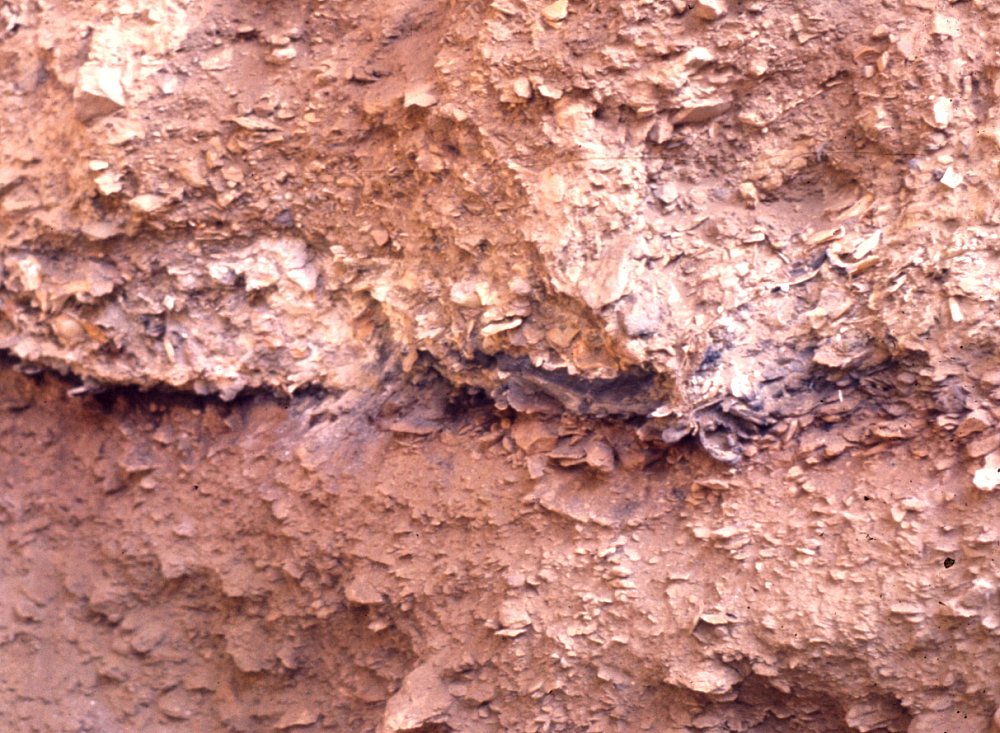 The
Archeology - Bone Bed 3
The
Archeology - Bone Bed 3
Bonfire Shelter takes its name from the inferno that consumed the uppermost buffalo jump deposit, Bone Bed 3, leaving behind the thick layer of charred and calcined bone that first drew archeologists to the site. Bone Bed 3 was thickest against the talus cone at the south end of the shelter and gradually became thinner toward the back and north end. Some of the bones in the thinner outer edges of the deposit are not burned, showing that the fire was concentrated in the main heap of bones. Within Bone Bed 3 were the mostly burned and jumbled bones of an estimated 800 bison, mostly cows (females) and yearling calves. The radiocarbon evidence and broad triangular dart points date Bone Bed 3 to approximately 800 B.C. or about 2800 years ago, during the Late Archaic period. A number of topics and questions about Bone Bed 3 continue to be debated.
It is uncertain whether Bone Bed 3 represents a single jump or several jumps closely spaced in time. Faunal analyst Dessamae Lorrain argued for only a single event, based on her finding that most of the animals were females and yearlings. In her opinion, such uniformity was unlikely to have occurred more than once. Most other experts who have weighed in on the matter disagree. Dave Dibble stated that "in view of the large number of animals present, the second alternative [multiple events] seems more logical." But he respected Lorrain's argument and acknowledged that no stratigraphic evidence of separate deposits was found. He did point out that the radiocarbon dates show that the upper deposits in Bonfire Shelter accumulated very slowly. Thus, if Bone Bed 3 did result from two or more jump events separated by relatively short periods of time (a few years or even several decades), the bones would have remained exposed between events and little or no discernable evidence would remain of the elapsed time. In other words, there would be no visible separation between the bones, such as a layer of dust, silt, rockfall, or other materials that, over time, tend to cover a site's surface, and that would indicate to archeologists a time lapse from one event to the next. The stratigraphic evidence was also impacted by the horrific fire that consumed the bones, but there were no obvious internal layers within Bone Bed 3 such as those found in Bone Bed 2.
Archeologist Elton Prewitt believes that the stylistic variation among the Bone Bed 3 dart points also suggests there may have been several jump episodes separated by hundreds of years. The broad-bladed triangular dart points found amid the buffalo bones include 3 Montell points, 2 side-notched points, an odd, stemmed point (probably a knife), and 19 basal- or corner-notched points that Dibble classified as "Castroville-like." He saw these 19 as variations on a single theme, but noted that among the variants were specimens that could be assigned to the Marcos, Marshall, Shumla, and Williams types. The stylistic attributes shared by these projectile point types have been noted by many archeologists working in central and southwestern Texas. This brings up an interesting question: what does the presence of so many similar but slightly different projectile points mean in terms of human behavior? This question has been much debated by archeologists, and no one answer reigns. Some archeologists are typological "splitters" and tend to separate projectile points into different variations and types based on rather minor differences. At the other end of the spectrum are the "lumpers" who prefer to see broad patterns and allow for a fair amount of variation within a named point type. In the mid-twentieth century, the idea that a single group of people (a tribe or band) would have used a single type of projectile point at any one time was popular: one point type = one group of people. But few archeologists would accept this idea today because there are many examples of different types found with (or in) a single burial or cache of artifacts, behavioral episodes that most likely represent the actions of a few closely related people at a single moment in time. From a splitter's perspective, there are many different types of points in Bone Bed 3, making it unlikely that all were in use by a single group (or several related and cooperating groups) at a single point in time. But a lumper, such as this writer (Black) and Dave Dibble in the present case, would not accept this argument. If indeed a single massive drive or several closely spaced large drives was responsible for Bone Bed 3, then we would assume that a fairly large group of people must have been involved - dozens perhaps even hundreds. Since most of the hunter-gatherer bands that were recorded in the general vicinity by the earliest Spanish explorers and missionaries were relatively small bands of less than 50 people, it might be assumed that several different bands participated in the prehistoric buffalo drives. Following this logic, the stylistic variation among the Late Archaic dart points in Bone Bed 3 could plausibly represent a single moment or short period of time.
Archeologist Mike Collins and paleontologist Ernest Lundelius once sat down and tried to calculate the volume that 800 buffalo would represent in cubic feet. Mike used his firsthand experience trying to load yearling cattle into cattle trailers and haul them off to market and figured out how many trailers it would take to hold 800 yearlings. Keep in mind that buffalo are bigger than cattle and that there were adult female buffalo along with the yearlings in Bone Bed 3. Neither Collins nor Lundelius kept the cocktail napkin upon which the calculations were made, but both are convinced that it would have been physically impossible for 800 buffalo, even small ones, to fit inside Bonfire Shelter, even assuming they filled the entire cavity. This leaves us with two possibilities: if the 800-animal estimate is more or less accurate, then this number plainly represents multiple jumps. Lundelius points out that if the jumps took place at the same time of the year (late winter or early spring), then the herd structure may well have been similar from jump to jump (contrary to Lorrain's assumption). The second possibility is that the 800-animal estimate is wrong and that far fewer animals are represented. But even if we assume that there were only half that many, 400 buffalo is still a huge amount. Assuming that a yearling weighs roughly 700 pounds, that is over a quarter of a million pounds of dead and dying animals, an awesome figure. The view favored here is that Bone Bed 3 is most likely the result of multiple jump episodes that occurred within a relatively short time span, a few decades to a few hundred years at most. But this is only an educated guess. This question is one of many lingering problems that could be solved in the future with new analytical techniques.
The artifacts found amid the burned bones include 38 dart points and fragments thereof (not counting the individual pieces of those that could be refitted), a bifacial knife, a side scraper, 2 hammerstones, a scratched pebble, 6 flake tools, and 22 unworked flakes. It is likely that some of the dart points were actually used as knives, as often is found to be the case when use-wear studies (microscopic examination of scars, polish, and other indicators of use) are done of projectile points. Even so, the tool inventory is rather sparse given the chore of butchering hundreds of bison. As was the case in both of the lower bone beds at the site, several large basketball-sized rocks were found amid the Bone Bed 3 bones. These were probably used as anvils to break apart bones and perhaps to dispatch wounded bison.  |







